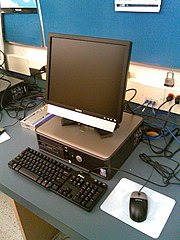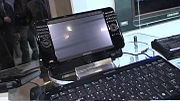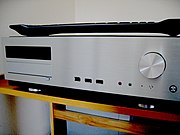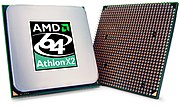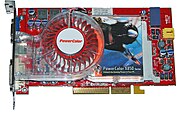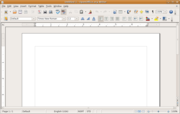personal computer (PC) is any general-purpose computer whose size, capabilities, and original sales price make it useful for individuals, and which is intended to be operated directly by an end user, with no intervening computer operator.
As of 2009, a personal computer may be a desktop computer, a laptop computer or a tablet computer. The most common operating systems for personal computers are Microsoft Windows, Mac OS and Linux, while the most common microprocessors are x86-compatible CPUs, ARM architecture CPUs and PowerPC CPUs. Software applications for personal computers include word processing, spreadsheets, databases, Web browsers and e-mail clients, games, and myriad personal productivity and special-purpose software. Modern personal computers often have high-speed or dial-up connections to the Internet, allowing access to the World Wide Web and a wide range of other resources.
A PC may be a home computer, or may be found in an office, often connected to a local area network (LAN). This is in contrast to the batch processing or time-sharing models which allowed large expensive systems to be used by many people, usually at the same time, or large data processing systems which required a full-time staff to operate efficiently.
While early PC owners usually had to write their own programs to do anything useful with the machines, today's users have access to a wide range of commercial and non-commercial software which is provided in ready-to-run form. Since the 1980s, Microsoft and Intel have been dominating much of the personal computer market with the Wintel platform.
Contents[hide] |
[edit] History
| This section needs additional citations for verification. Please help improve this article by adding reliable references. Unsourced material may be challenged and removed. (September 2008) |

The capabilities of the personal computer have changed greatly since the introduction of electronic computers. By the early 1970s, people in academic or research institutions had the opportunity for single-person use of a computer system in interactive mode for extended durations, although these systems would still have been too expensive to be owned by a single person. The introduction of the microprocessor, a single chip with all the circuitry that formerly occupied large cabinets, led to the proliferation of personal computers after about 1975. Early personal computers - generally called microcomputers - were sold often in Electronic kit form and in limited volumes, and were of interest mostly to hobbyists and technicians. Minimal programming was done by toggle switches, and output was provided by front panel indicators. Practical use required peripherals such as keyboards, computer terminals, disk drives, and printers. Unlike other hobbyist computers of its day, which were sold as kits; in 1976 Steve Jobs and Steve Wozniak sold the Apple I was a fully assembled circuit board containing about 30 chips. Such that by 1977 Apple Computers introduced the Apple II, as the world’s first personal computer. By 1977, mass-market pre-assembled computers allowed a wider range of people to use computers, focusing more on software applications and less on development of the processor hardware.
Throughout the late 1970s and into the 1980s, computers were developed for household use, offering personal productivity, programming and games. Somewhat larger and more expensive systems (although still low-cost compared with minicomputers and mainframes) were aimed for office and small business use. Workstations are characterized by high-performance processors and graphics displays, with large local disk storage, networking capability, and running under a multitasking operating system. Workstations are still used for tasks such as computer-aided design, drafting and modelling, computation-intensive scientific and engineering calculations, image processing, architectural modelling, and computer graphics for animation and motion picture visual effects.[1]
Eventually the market segments lost any technical distinction; business computers acquired color graphics capability and sound, and home computers and game systems users used the same processors and operating systems as office workers. Mass-market computers had graphics capabilities and memory comparable to dedicated workstations of a few years before. Even local area networking, originally a way to allow business computers to share expensive mass storage and peripherals, became a standard feature of the personal computers used at home.
[edit] Market and sales
In 2001 125 million personal computers were shipped in comparison to 48 thousand in 1977. More than 500 million personal computers were in use in 2002 and one billion personal computers had been sold worldwide since mid-1970s until this time. Of the latter figure, 75 percent were professional or work related, while the rest sold for personal or home use. About 81.5 percent of personal computers shipped had been desktop computers, 16.4 percent laptops and 2.1 percent servers. United States had received 38.8 percent (394 million) of the computers shipped, Europe 25 percent and 11.7 percent had gone to Asia-Pacific region, the fastest-growing market as of 2002. The second billion was expected to be sold by 2008.[2] Almost half of all the households in Western Europe had a personal computer and a computer could be found in 40 percent of homes in United Kingdom, compared with only 13 percent in 1985.[3]
The global personal computer shipments were 264 million units in the year 2007, according to iSuppli[4], up 11.2 percent from 239 million in 2006.[5]. In year 2004, the global shipments was 183 million units, 11.6 percent increase over 2003.[6] In 2003, 152.6 million computers were shipped, at an estimated value of $175 billion.[7] In 2002, 136.7 million PCs were shipped, at an estimated value of $175 billion.[7] In 2000, 140.2 million personal computers were shipped, at an estimated value of $226 billion.[7] Worldwide shipments of personal computers surpassed the 100-million mark in 1999, growing to 113.5 million units from 93.3 million units in 1998.[8]. In 1999, Asia had 14.1 million units shipped.[9]
As of June 2008, the number of personal computers in use worldwide hit one billion, while another billion is expected to be reached by 2014. Mature markets like the United States, Western Europe and Japan accounted for 58 percent of the worldwide installed PCs. The emerging markets were expected to double their installed PCs by 2013 and to take 70 percent of the second billion PCs. About 180 million computers (16 percent of the existing installed base) were expected to be replaced and 35 million to be dumped into landfill in 2008. The whole installed base grew 12 percent annually.[10][11]
In the developed world, there has been a vendor tradition to keep adding functions to maintain high prices of personal computers. However, since the introduction of One Laptop per Child foundation and its low-cost XO-1 laptop, the computing industry started to pursue the price too. Although introduced only one year earlier, there were 14 million netbooks sold in 2008.[12] Besides the regular computer manufacturers, companies making especially rugged versions of computers have sprung up, offering alternatives for people operating their machines in extreme weather or environments.[13]
[edit] Average selling price
For Microsoft Windows systems, the average selling price (ASP) showed a decline in 2008/2009, possibly due to low-cost netbooks, drawing $569 for desktop computers and $689 for laptops at U.S. retail in August 2008. In 2009, ASP had further fallen to $533 for desktops and to $602 for notebooks by January and to $540 and $560 in February.[14]
[edit] Netbooks and nettops
The emergence of new market segment of small, energy-efficient and low-cost devices designed for access to the Internet (netbooks and nettops) could threaten established companies like Microsoft, Intel, HP or Dell, analysts said in July 2008. A market research firm International Data Corporation predicted that the category could grow from fewer than 500,000 in 2007 to 9 million in 2012 as the market for low cost and secondhand computers expands in developed economies. [15] Also, after Microsoft ceased selling consumer versions of Windows XP, it made an exception and continued to offer the operating system for netbook and nettop makers.[16]
[edit] Types
[edit] Workstation
A workstation is a high-end personal computer designed for technical or scientific applications. Intended primarily to be used by one person at a time, they are commonly connected to a local area network and run multi-user operating systems.
[edit] Desktop computer
Prior to the wide spread of PCs a computer that could fit on a desk was considered remarkably small. Today the phrase usually indicates a particular style of computer case. Desktop computers come in a variety of styles ranging from large vertical tower cases to small form factor models that can be tucked behind an LCD monitor. In this sense, the term 'desktop' refers specifically to a horizontally-oriented case, usually intended to have the display screen placed on top to save space on the desk top. Most modern desktop computers have separate screens and keyboards.
[edit] Single Unit
A subtype of desktop, called Single Unit PCs, (Otherwise known as All-in-One PCs). These Personal Computers combine the monitor with the case of the unit into a single unit. The monitor almost always utilizes a Touch Screen as the primary user input, however detached keyboards and mice are not uncommon. The inner components of the PC are located directly behind the monitor.
[edit] Nettop
A subtype of desktops, called nettops, was introduced by Intel in February 2008 to describe low-cost, lean-function, desktop computers. A similar subtype of laptops (or notebooks) are the netbooks (see below).
[edit] Laptop

A laptop computer or simply laptop, also called a notebook computer or sometimes a notebook, is a small personal computer designed for mobility. Usually all of the interface hardware needed to operate the laptop, such as parallel and serial ports, graphics card, sound channel, etc., are built in to a single unit. Most laptops contain batteries to facilitate operation without a readily available electrical outlet. In the interest of saving power, weight and space, they usually share RAM with the video channel, slowing their performance compared to an equivalent desktop machine.
One main drawback of the laptop is that, due to the size and configuration of components, relatively little can be done to upgrade the overall computer from its original design. Some devices can be attached externally through ports (including via USB), however internal upgrades are not recommended or in some cases impossible, making the desktop PC more modular.
A subtype of notebooks, called subnotebooks, are computers with most of the features of a standard laptop computer but smaller. They are larger than hand-held computers, and usually run full versions of desktop/laptop operating systems. Ultra-Mobile PCs (UMPC) are usually considered subnotebooks, or more specifically, subnotebook Tablet PCs (see below). Netbooks are sometimes considered in this category, though they are sometimes separated in a category of their own (see below).
Desktop replacements, meanwhile, are large laptops meant to replace a desktop computer while keeping the mobility of a laptop.
[edit] Netbook
Netbook PCs are small portable computers in a "clamshell" design, that are designed specifically for wireless communication and access to the Internet. They are generally much lighter and cheaper than subnotebooks, and have a smaller display, between 7" and 9", with a screen resolution between 800x600 and 1024x768 but newer models feature higher resolution at up to 1280x768 like the Gigabyte M912X netbook. The operating systems and applications on them are usually specially modified so they can be comfortably used with a smaller sized screen, and the OS is often based on Linux, although some netbooks run on Windows XP and Windows Vista (For example Sony's Tablet Netbook PCs). Some netbooks make use of their built in high speed Wireless connectivity to offload some of their applications software to Internet servers, through the principle of Cloud computing, as most have small solid state storage systems instead of hard-disks. Storage capacities were usually in the 4 to 16 GB range but have largely increased expanding up to 160GB for example the Gigabyte M912X and the MSI WInd U100 with units that have hard drives instead of solid state drives. One of the first examples of such a system was the original Eee PC.
[edit] Tablet PC
A tablet PC is a notebook or slate-shaped mobile computer, first introduced by Pen computing in the early 90s with their PenGo Tablet Computer and popularized by Microsoft. Its touchscreen or graphics tablet/screen hybrid technology allows the user to operate the computer with a stylus or digital pen, or a fingertip, instead of a keyboard or mouse. The form factor offers a more mobile way to interact with a computer. Tablet PCs are often used where normal notebooks are impractical or unwieldy, or do not provide the needed functionality.
[edit] Ultra-Mobile PC
The ultra-mobile PC (UMPC) is a specification for a small form factor tablet PC. It was developed as a joint development exercise by Microsoft, Intel, and Samsung, among others. Current UMPCs typically feature the Windows XP Tablet PC Edition 2005, Windows Vista Home Premium Edition, or Linux operating system and low-voltage Intel Pentium or VIA C7-M processors in the 1 GHz range.
[edit] Home Theater PC
A home theater PC (HTPC) is a convergence device that combines the functions of a personal computer and a digital video recorder. It is connected to a television or a television-sized computer display and is often used as a digital photo, music, video player, TV receiver and digital video recorder. Home theater PCs are also referred to as media center systems or media servers. The general goal in a HTPC is usually to combine many or all components of a home theater setup into one box. They can be purchased pre-configured with the required hardware and software needed to add television programming to the PC, or can be cobbled together out of discrete components as is commonly done with Windows Media Center, GB-PVR, SageTV, Famulent or LinuxMCE.
[edit] Pocket PC
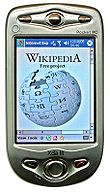
A pocket PC is a hardware specification for a handheld-sized computer (personal digital assistant) that runs the Microsoft Windows Mobile operating system. It may have the capability to run an alternative operating system like NetBSD or Linux. It has many of the capabilities of modern desktop PCs.
Currently there are tens of thousands of applications for handhelds adhering to the Microsoft Pocket PC specification, many of which are freeware. Some of these devices also include mobile phone features. Microsoft compliant Pocket PCs can also be used with many other add-ons like GPS receivers, barcode readers, RFID readers, and cameras. In 2007, with the release of Windows Mobile 6, Microsoft dropped the name Pocket PC in favor of a new naming scheme. Devices without an integrated phone are called Windows Mobile Classic instead of Pocket PC. Devices with an integrated phone and a touch screen are called Windows Mobile Professional.[17]
[edit] Hardware
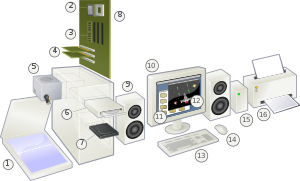
A typical hardware setup of a desktop computer consists of:
- computer case with power supply
- central processing unit (processor)
- motherboard
- memory card
- hard disk
- video card
- visual display unit (monitor)
- optical disc (usually DVD-ROM or DVD Writer)
- keyboard and pointing device
These components can usually be put together with little knowledge to build a computer. The motherboard is a main part of a computer that connects all devices together. The memory card(s), graphics card and processor are mounted directly onto the motherboard (the processor in a socket and the memory and graphics cards in expansion slots). The mass storage is connected to it with cables and can be installed in the computer case or in a separate case. This is the same for the keyboard and mouse, except that they are external and connect to the I/O panel on the back of the computer. The monitor is also connected to the I/O panel, either through an onboard port on the motherboard, or a port on the graphics card.
Several functions (implemented by chipsets) can be integrated into the motherboard, typically USB and network, but also graphics and sound. Even if these are present, a separate card can be added if what is available isn't sufficient. The graphics and sound card can have a break out box to keep the analog parts away from the electromagnetic radiation inside the computer case. For really large amounts of data, a tape drive can be used or (extra) hard disks can be put together in an external case.
The hardware capabilities of personal computers can sometimes be extended by the addition of expansion cards connected via an expansion bus. Some standard peripheral buses often used for adding expansion cards in personal computers as of 2005 are PCI, AGP (a high-speed PCI bus dedicated to graphics adapters), and PCI Express. Most personal computers as of 2005 have multiple physical PCI expansion slots. Many also include an AGP bus and expansion slot or a PCI Express bus and one or more expansion slots, but few PCs contain both buses.
[edit] Computer case
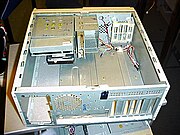
A computer case is the enclosure that contains the main components of a computer. Cases are usually constructed from steel, aluminium, or plastic, although other materials such as wood, plexiglas or fans[18] have also been used in case designs. Cases can come in many different sizes, or form factors. The size and shape of a computer case is usually determined by the form factor of the motherboard that it is designed to accommodate, since this is the largest and most central component of most computers. Consequently, personal computer form factors typically specify only the internal dimensions and layout of the case. Form factors for rack-mounted and blade servers may include precise external dimensions as well, since these cases must themselves fit in specific enclosures.
Currently, the most popular form factor for desktop computers is ATX, although microATX and small form factors have become very popular for a variety of uses. Companies like Shuttle Inc. and AOpen have popularized small cases, for which FlexATX is the most common motherboard size.
[edit] Central processing unit
The central processing unit, or CPU, is that part of a computer which executes software program instructions. In older computers this circuitry was formerly on several printed circuit boards, but in PCs is a single integrated circuit. Nearly all PCs contain a type of CPU known as a microprocessor. The microprocessor often plugs into the motherboard using one of many different types of sockets. IBM PC compatible computers use an x86-compatible processor, usually made by Intel, AMD, VIA Technologies or Transmeta. Apple Macintosh computers were initially built with the Motorola 680x0 family of processors, then switched to the PowerPC series (a RISC architecture jointly developed by Apple Computer, IBM and Motorola), but as of 2006, Apple switched again, this time to x86-compatible processors by Intel. Modern CPUs are equipped with a fan attached via heat sink.
[edit] Motherboard
The motherboard, also referred to as systemboard or mainboard, is the primary circuit board within a personal computer. Many other components connect directly or indirectly to the motherboard. Motherboards usually contain one or more CPUs, supporting circuitry - usually integrated circuits (ICs) - providing the interface between the CPU memory and input/output peripheral circuits, main memory, and facilities for initial setup of the computer immediately after power-on (often called boot firmware or, in IBM PC compatible computers, a BIOS). In many portable and embedded personal computers, the motherboard houses nearly all of the PC's core components. Often a motherboard will also contain one or more peripheral buses and physical connectors for expansion purposes. Sometimes a secondary daughter board is connected to the motherboard to provide further expandability or to satisfy space constraints.
[edit] Main memory
A PC's main memory is fast storage that is directly accessible by the CPU, and is used to store the currently executing program and immediately needed data. PCs use semiconductor random access memory (RAM) of various kinds such as DRAM or SRAM as their primary storage. Which exact kind depends on cost/performance issues at any particular time. Main memory is much faster than mass storage devices like hard disks or optical discs, but is usually volatile, meaning it does not retain its contents (instructions or data) in the absence of power, and is much more expensive for a given capacity than is most mass storage. Main memory is generally not suitable for long-term or archival data storage.
[edit] Hard disk
Mass storage devices store programs and data even when the power is off; they do require power to perform read and write functions during usage. Although semiconductor flash memory has dropped in cost, the prevailing form of mass storage in personal computers is still the electromechanical hard disk.
The disk drives use a sealed head/disk assembly (HDA) which was first introduced by IBM's "Winchester" disk system. The use of a sealed assembly allowed the use of positive air pressure to drive out particles from the surface of the disk, which improves reliability.
If the mass storage controller provides for expandability, a PC may also be upgraded by the addition of extra hard disk or optical disc drives. For example, DVD-ROMs, CD-ROMs, and various optical disc recorders may all be added by the user to certain PCs. Standard internal storage device interfaces are ATA, Serial ATA, SCSI, and CF+ type II in 2005.
[edit] Video card
The video card - otherwise called a graphics card, graphics adapter or video adapter - processes and renders the graphics output from the computer to the computer display, also called the visual display unit (VDU), and is an essential part of the modern computer. On older models, and today on budget models, graphics circuitry tended to be integrated with the motherboard but, for modern flexible machines, they are supplied in PCI, AGP, or PCI Express format.
When the IBM PC was introduced, most existing business-oriented personal computers used text-only display adapters and had no graphics capability. Home computers at that time had graphics compatible with television signals, but with low resolution by modern standards owing to the limited memory available to the eight-bit processors available at the time.
[edit] Visual display unit

A visual display unit (or monitor) is a piece of electrical equipment, usually separate from the computer case, which displays viewable images generated by a computer without producing a permanent record. The word "monitor" is used in other contexts; in particular in television broadcasting, where a television picture is displayed to a high standard. A computer display device is usually either a cathode ray tube or some form of flat panel such as a TFT LCD. The monitor comprises the display device, circuitry to generate a picture from electronic signals sent by the computer, and an enclosure or case. Within the computer, either as an integral part or a plugged-in interface, there is circuitry to convert internal data to a format compatible with a monitor. The images from monitors originally contained only text, but as Graphical user interfaces emerged and became common, they began to display more images and multimedia content.
[edit] Keyboards
In computing, a keyboard is an arrangement of buttons that each correspond to a function, letter, or number. They are the primary devices of inputing text. In most cases, they contain an aray of keys specifically organized with the corresponding letters, numbers, and functions printed or engraved on the button. They are generally designed around an operators language, and many different versions for different languages exist. In English, the most common layout is the QWERTY layout, which was originally used in typewriters. They have evolved over time, and have been modified for use in computers with the addition of function keys, number keys, arrow keys, and OS specific keys. Often, specific functions can be achieved by pressing multiple keys at once or in succession, such as inputing characters with accents or opening a task manager. Programs use keyboard shotcuts very differently and all use different keyboard shortcuts for different program specific operations, such as refreshing a web page in a web browser or selecting all text in a word processor.
[edit] Mouse
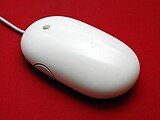
A Mouse on a computer is a small, slidable device that users hold and slide around to point at, click, and sometimes drag objects on screen in a graphical user interface using a pointer on screen. Almost all Personal Computers have mice. It may be plugged into a computer's rear mouse socket, or as a USB device, or, more recently, may be connected wirelessly via a USB antenna or Bluetooth antenna. In the past, they had a single button that users could press down on the device to "click" on whatever the pointer on the screen was hovering over. Now, however, many Mice have two or three buttons; a "right click" function button on the mouse, which performs a secondary action on a selected object, and a scroll wheel, which users can rotate the wheel using their fingers to "scroll" up or down. The scroll wheel can also be pressed down, and therefore be used as a third button. Different programs make use of these functions differently, and may scroll horizontally by default with the scroll wheel, open different menus with different buttons, among others.
Mice traditionally detected movement and communicated with the computer with an internal "mouse ball"; and use optical encoders to detect rotation of the ball and tell the computer where the mouse has moved. However, these systems were subject to low durability and accuracy. Modern mice use optical technology to directly trace movement of the surface under the mouse and are much more accurate and durable. They work on a wider variety of surfaces and can even operate on walls, ceilings or other non-horizontal surfaces.
[edit] Other components
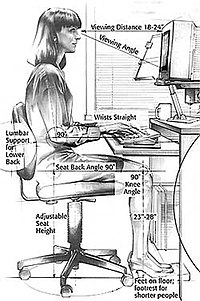
- Mass storage
All computers require either fixed or removable storage for their operating system, programs and user generated material.
Formerly the 5 1/4 inch and 3 1/2 inch floppy drive were the principal forms of removable storage for backup of user files and distribution of software.
As memory sizes increased, the capacity of the floppy did not keep pace; the Zip drive and other higher-capacity removable media were introduced but never became as prevalent as the floppy drive.
By the late 1990s the optical drive, in CD and later DVD and Blu-ray Disc, became the main method for software distribution, and writeable media provided backup and file interchange. Floppy drives have become uncommon in desktop personal computers since about 2000, and were dropped from many laptop systems even earlier. [20]
Early home computers used compact audio cassettes for file storage; these were at the time a very low cost storage solution, but were displaced by floppy disk drives when manfacturing costs dropped, by the mid 1980s.
A second generation of tape recorders was provided when Videocassette recorders were pressed into service as backup media for larger disk drives. All these systems were less reliable and slower than purpose-built magnetic tape drives. Such tape drives were uncommon in consumer-type personal computers but were a necessity in business or industrial use.
Interchange of data such as photographs from digital cameras is greatly expedited by installation of a card reader, which often is compatible with several forms of flash memory. It is usually faster and more convenient to move large amounts of data by removing the card from the mobile device, instead of communicating with the mobile device through a USB interface.
A USB flash drive today performs much of the data transfer and backup functions formerly done with floppy drives, Zip disks and other devices. Main-stream current operating systems for personal computers provide standard support for flash drives, allowing interchange even between computers using different processors and operating systems. The compact size and lack of moving parts or dirt-sensitive media, combined with low cost for high capacity, have made flash drives a popular and useful accessory for any personal computer user.
The operating system (e.g.: Microsoft Windows, Mac OS, Linux or many others) can be located on any storage, but typically it is on a hard disks. A Live CD is the running of a OS directly from a CD. While this is slow compared to storing the OS on a hard drive, it is typically used for installation of operating systems, demonstrations, system recovery, or other special purposes. Large flash memory is currently more expensive than hard drives of similar size (as of mid-2008) but are starting to appear in laptop computers because of their low weight, small size and low power requirements.
- Computer communications
- Common peripherals and adapter cards
- Headset
- Joystick
- Microphone
- Printer
- Scanner
- Sound adapter card as a separate card rather than located on the motherboard
- Speakers
- Webcam
[edit] Software
Computer software is a general term used to describe a collection of computer programs, procedures and documentation that perform some tasks on a computer system.[21] The term includes application software such as word processors which perform productive tasks for users, system software such as operating systems, which interface with hardware to provide the necessary services for application software, and middleware which controls and co-ordinates distributed systems.
Software applications for word processing, Internet browsing, Internet faxing, e-mail and other digital messaging, multimedia playback, computer game play and computer programming are common. The user of a modern personal computer may have significant knowledge of the operating environment and application programs, but is not necessarily interested in programming nor even able to write programs for the computer. Therefore, most software written primarily for personal computers tends to be designed with simplicity of use, or "user-friendliness" in mind. However, the software industry continuously provide a wide range of new products for use in personal computers, targeted at both the expert and the non-expert user.
[edit] Operating system
An operating system (OS) manages computer resources and provides programmers with an interface used to access those resources. An operating system processes system data and user input, and responds by allocating and managing tasks and internal system resources as a service to users and programs of the system. An operating system performs basic tasks such as controlling and allocating memory, prioritizing system requests, controlling input and output devices, facilitating computer networking and managing files.
Common contemporary desktop OSes are Microsoft Windows (~91% market share)[22], Mac OS X (~8%)[23], Linux (0.7%), Solaris and PC-BSD. Windows, Mac, and Linux all have server and personal variants. With the exception of Microsoft Windows, the designs of each of the aforementioned OSs were inspired by, or directly inherited from, the Unix operating system. Unix was developed at Bell Labs beginning in the late 1960s and spawned the development of numerous free and proprietary operating systems.
[edit] Microsoft Windows
Microsoft Windows is the name of several families of software operating systems by Microsoft. Microsoft first introduced an operating environment named Windows in November 1985 as an add-on to MS-DOS in response to the growing interest in graphical user interfaces (GUIs).[24][25] The most recent client version of Windows is Windows Vista and the current server version is Windows Server 2008. A new version, Windows 7, is currently in development and is available as a Release Candidate. [26]
[edit] Linux
Linux is a family of Unix-like computer operating systems. Linux is one of the most prominent examples of free software and open source development: typically all underlying source code can be freely modified, used, and redistributed by anyone.[27] The name "Linux" comes from the Linux kernel, started in 1991 by Linus Torvalds. The system's utilities and libraries usually come from the GNU operating system, announced in 1983 by Richard Stallman. The GNU contribution is the basis for the alternative name GNU/Linux.[28]
Predominantly known for its use in servers, Linux is supported by corporations such as Dell, Hewlett-Packard, IBM, Novell, Oracle Corporation, Red Hat, Canonical Ltd. and Sun Microsystems. It is used as an operating system for a wide variety of computer hardware, including desktop computers, supercomputers,[29] video game systems, such as the PlayStation 3, several arcade games, and embedded devices such as mobile phones, routers, and stage lighting systems.
[edit] Mac OS X
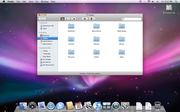
Mac OS X is a line of graphical operating systems developed, marketed, and sold by Apple Inc.. Mac OS X is the successor to the original Mac OS, which had been Apple's primary operating system since 1984. Unlike its predecessors, Mac OS X is a Unix-based operating system.
[edit] Applications
| This section does not cite any references or sources. Please help improve this article by adding citations to reliable sources. Unverifiable material may be challenged and removed. (June 2008) |
Application software employs the capabilities of a computer directly and thoroughly to a task that the user wishes to perform. This should be contrasted with system software which is involved in integrating a computer's various capabilities, but typically does not directly apply them in the performance of tasks that benefit the user. In this context the term application refers to both the application software and its implementation. A simple, if imperfect analogy in the world of hardware would be the relationship of an electric light bulb (an application) to an electric power generation plant (a system). The power plant merely generates electricity, not itself of any real use until harnessed to an application like the electric light that performs a service that benefits the user.
Typical examples of software applications are word processors, spreadsheets, and media players. Multiple applications bundled together as a package are sometimes referred to as an application suite. Microsoft Office and OpenOffice.org, which bundle together a word processor, a spreadsheet, and several other discrete applications, are typical examples. The separate applications in a suite usually have a user interface that has some commonality making it easier for the user to learn and use each application. And often they may have some capability to interact with each other in ways beneficial to the user. For example, a spreadsheet might be able to be embedded in a word processor document even though it had been created in the separate spreadsheet application.
End-user development tailors systems to meet the user's specific needs. User-written software include spreadsheet templates, word processor macros, scientific simulations, graphics and animation scripts. Even email filters are a kind of user software. Users create this software themselves and often overlook how important it is.
[edit] Lifetime
| This section does not cite any references or sources. Please help improve this article by adding citations to reliable sources. Unverifiable material may be challenged and removed. (April 2008) |
Most personal computers are standardized to the point that purchased software is expected to run with little or no customization for the particular computer. Many PCs are also user-upgradeable, especially desktop and workstation class computers. Devices such as main memory, mass storage, even the motherboard and central processing unit may be easily replaced by an end user. This upgradeability is, however, not indefinite due to rapid changes in the personal computer industry. A PC that was considered top-of-the-line five or six years prior may be impractical to upgrade due to changes in industry standards. Such a computer usually must be totally replaced once it is no longer suitable for its purpose. This upgrade and replacement cycle is partially related to new releases of the primary mass-market operating system, which tends to drive the acquisition of new hardware and render obsolete previously serviceable hardware (planned obsolescence).
The processing environment may also render an older computer obsolete even if it is still in good working order. As the memory (RAM) and processing speed of the average computer increases, websites are built or rebuilt based on the expectation of this increased computing power. This spurs the development of still faster processors and higher RAM capacities, as the cycle continues.
Due to the extremely short life-span of the average PC in the U.S. alone approximately 130,000 personal computers are thrown out a day. This statistic supports the growing importance of electronic recycling. [30]
[edit] See also
- Desktop computer
- Desktop replacement computer
- Gaming PC
- List of computer system manufacturers
- Personal Computer Museum
- Public computer
- Quiet PC
- Supercomputer
- e-waste
- Information and communication technologies for development
[edit] Notes
- Accidental Empires: How the boys of Silicon Valley make their millions, battle foreign competition, and still can't get a date, Robert X. Cringely, Addison-Wesley Publishing, (1992), ISBN 0-201-57032-7
[edit] References
- ^ Ralston, Anthony; Reilly, Edwin (1993). "Workstation". Encyclopedia of Computer Science (Third Edition ed.). New York: Van Nostrand Reinhold. ISBN 0442276796.
- ^ personal computers: More than 1 billion served
- ^ Computers reach one billion mark
- ^ ISuppli Raises 2007 Computer Sales Forecast, pcworld.com, accessed at 13 January 2009
- ^ iSuppli raises 2007 computer sales forecast, macworld.co.uk, accessed at 13 January 2009
- ^ Global PC Sales Leveling Off, newsfactor.com, accessed at 13 January 2009
- ^ a b c HP back on top of PC market, accessed at 13 January 2009
- ^ Dell Passes Compaq as Top PC Seller in U.S, latimes.com, accessed at 13 January 2009
- ^ Economic recovery bumps AP 1999 PC shipments to record high, zdnetasia.com, accessed at 13 January 2009
- ^ Gartner Says More than 1 Billion PCs In Use Worldwide and Headed to 2 Billion Units by 2014
- ^ Computers in use pass 1 billion mark: Gartner
- ^ http://www.olpcnews.com/use_cases/technology/4p_computing_olpc_impact.html
- ^ Rugged PC leaders
- ^ http://www.eweek.com/c/a/Windows/Netbooks-Are-Destroying-the-Laptop-Market-and-Microsoft-Needs-to-Act-Now-863307/
- ^ Low cost computer guide
- ^ Smaller PCs Cause Worry for Industry - NYTimes.com
- ^ New Windows Mobile 6 Devices :: Jun/Jul 2007
- ^ pete edge...casefancasefancase
- ^ Berkeley Lab. Integrated Safety Management: Ergonomics. Website. Retrieved 9 July 2008.
- ^ The NeXT computer introduced in 1988 did not include a floppy drive, which at the time was unusual.
- ^ "Wordreference.com: WordNet 2.0". Princeton University, Princeton, NJ. http://www.wordreference.com/definition/software. Retrieved on 2007-08-19.
- ^ [1]- Marketshare.com
- ^ [2]- Marketshare.com
- ^ "http://inventors.about.com/od/mstartinventions/a/Windows.htm?rd=1". http://inventors.about.com/od/mstartinventions/a/Windows.htm?rd=1. Retrieved on 2007-04-22.
- ^ IDC: Consolidation to Windows won't happen
- ^ "Windows 7 RC available". Ars Technica. 30 April, 2009. http://arstechnica.com/microsoft/news/2009/04/windows-7-rc-arrives-on-technet-msdn-connect.ars. Retrieved on 2009-05-27.
- ^ "Linux Online ─ About the Linux Operating System". Linux.org. http://www.linux.org/info/index.html. Retrieved on 2007-07-06.
- ^ Weeks, Alex (2004). "1.1". Linux System Administrator's Guide (version 0.9 ed.). http://www.tldp.org/LDP/sag/html/sag.html#GNU-OR-NOT. Retrieved on 2007-01-18.
- ^ Lyons, Daniel. "Linux rules supercomputers". http://www.forbes.com/home/enterprisetech/2005/03/15/cz_dl_0315linux.html. Retrieved on 2007-02-22.
- ^ http://www.cbsnews.com/stories/2008/11/06/60minutes/main4579229.shtml?source=search_story
[edit] External links
| Wikimedia Commons has media related to: Personal computers |
| Wikiversity has learning materials about Introduction to Computers/Personal |
| Look up personal computer in Wiktionary, the free dictionary. |
| Wikiquote has a collection of quotations related to: Personal computer |

